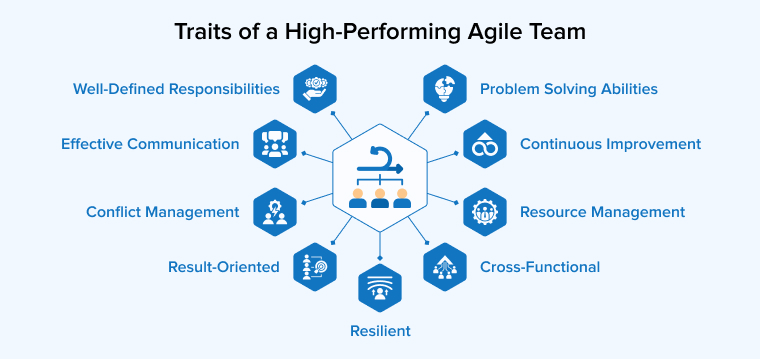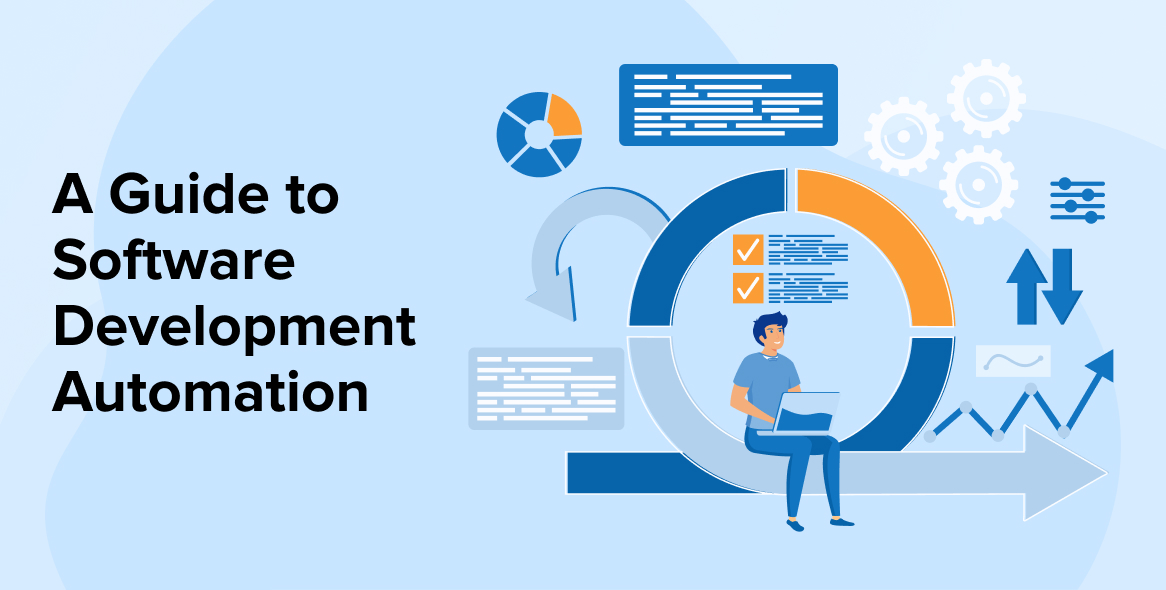
The process of software development needs to be expedited and businesses have found a way to develop software and meet customer satisfaction benchmarks. By the title Agile Team Characteristics, you would have guessed which methodology we are speaking about. Agile methods have been in business for over two decades and their existence is leveraged by many businesses now. The initialization of Agile practices started in the manifesto when the representatives from all types of programming met from extreme programming Scrum, feature-driven programming, and other pragmatic programming languages. That’s when the initialization of Agile as a methodology took place.
If Agile can be a methodology then the teams using Agile methodology can be considered Agile teams, right? Absolutely! Agile team characteristics show that they are extremely efficient and they work in tandem with other teams to deliver desired results on time. You as a business can harness a lot of benefits if you make Agile a part of your business. In this blog, we will be seeing all the essential factors that play a vital role in making your agile team successful in a software development company.
Firstly let us start to know what is an Agile team?
1. What is an Agile Team?
An Agile team is a team that works cross-functionally with other people in the group that are involved in defining, building, testing, and delivering a value increment in a limited amount of time. Agile software development teams work with smaller teams to make communication stronger and more transparent. So, if you are planning to have a team of 8 developers for your project, making it a team of 2 with 4 people in each team is what Agile teams do. There is a broad range of services that such teams intend to do and with Agile, it can be done simultaneously. Technical teams who understand the technicalities will define the needs, create a roadmap, and develop, test, and deploy elements to bring the value of their created solution.
Here are technical teams who also know, understand, and define the needs, start building the solution, test, and deploy some elements of Solution value.
1.1 High Performing Agile Team
Agile Teams have become a preferable choice for businesses because they assure enterprises with consistent high-quality work. The process of creating high-performing teams is an act of gathering the right resources with the right set of knowledge and skill set. This selected team will also be good at managing tasks simultaneously and will be best at accepting and embracing the Agile mindset.
With the inducement of an Agile mindset, you can have teams that can help you thrive and grow efficiently. In order to deliver the best-in-class business value, there are some of the common traits that you can find in high-performing Agile teams:
- Agile provides your team with a risk-free environment in which to experiment without fear of embarrassment.
- There is an alignment on a shared vision with clear goals and objectives.
- Knowledge and skill set that allows the team to make quick, and effective decisions on their own
- There is an equivalent trust that is mutual which takes care of healthy conflict.
- High-performance Agile teams can have accountability to one another and to the organization by consistently finishing work and accomplishing benchmarks.
- Understanding the future impact of their work on the organization.
- They have a good time at work and with each other.
2. Traits of a High-Performing Agile Team

Following are the traits of a high-performing agile team:
2.1 Well-Defined Responsibilities
To achieve great things, an agile team must be self-sufficient and self-organizing. This means every member of the team should be able to take responsibility. Each team member must be able to determine what is currently going on, and what is there as the next tasks. Teams must be able to organize meetings among themselves if needed, as well as with external collaborators or stakeholders, without much guidance from higher-level executives.
The reason behind more productive Agile teams is the ideology of taking up responsibilities on their own. The more self-sufficient a team is, the more consistently it will perform. The better the team performs, the better will be the results the organization can deliver. A self-sufficient agile team needs agile project management tools to support their way of working and may benefit from using project management tools to plan their springs and manage tasks independently without the need for a traditional project manager.
2.2 Effective Communication and Collaboration
If there is a synonym for the word Agile then it is Communication and Collaboration. Undoubtedly, Agile teams must have this characteristic in order to smoothly process their day-to-day activities. Agile team members are eager to collaborate, share common beliefs, and work toward a common goal. The team considers various ideas and comes to an agreement on the systems and techniques to be used to achieve the desired profitability. The team is eager to collaborate with other teams to define new ways to learn on a continuous basis.
The Agile team promotes open and regular communication and information sharing within the team. The roles are defined, and the team ensures that everyone’s opinion is respected and valued. It entails being capable of understanding the intent and valuable opinion of others, as well as openly discussing the desired outcomes, what value is expected, and the goals that need to be accomplished in each Sprint. The team also consults with people outside the company.
2.3 Cross-Functional
The Agile team has all of the necessary skills required for the efficient development and delivery of a product/service increment. It entails team members with vivid functional expertise to work collaboratively and achieve a simple and common organizational goal. The team understands the purpose completely and strives for consistent competence development in collaboration with other teams within the organization.
2.4 Resilient
There are many incidents where an Agile team has to deal with uncertainty and unfortunate circumstances. They have to be strong and collaborative. The team operates in a safe environment wherein you must consider all challenges as opportunities. They consider the possible consequences and maintain a positive attitude in which everyone can openly express their concerns and support one another. The team has a strong level of reliability and faithfulness, that is the strength of the team to find opportunities for growth and deliver solutions and services even in difficult circumstances.
2.5 Continuous Improvement
One of the biggest benefits of Agile is that you work simultaneously and the processes are divided into sprints. These sprints are in such a pattern that it would work on the basis of consistent feedback. It can improve team performance. In this process of Agile
To ensure effective product development and continuous improvement, the Agile team can respond to constant changes and take calculated risks to try new things. The team has the courage to hold themselves and others accountable for the work that needs to be done, as well as to ensure that the Agile Principles and Scrum values are followed correctly. It also entails giving and receiving constructive feedback from team members on a regular basis. The team has a strong sense of psychological safety.
2.6 Conflict Management
The Agile team has one superpower that it can easily recognize, and resolve conflicts and disagreements in a timely manner. Since it’s a chain of events, everyone in the chain cannot be on the same page. Thus, in case of conflict, you must make everyone align on the same page. Everyone ensures that the team’s diversity does not impact the overall product. There can be differing opinions, skills, and experiences, their views are respected, and conflicts and disagreements result in positive change. The team’s conflict is neither too frequent nor too rare.
2.7 Problem Solving Abilities
The Agile team uses a collective analytical mindset to address issues that obstruct the timely and effective development and delivery of a product or service. A successful Agile team understands this and accomplishes it by proactively identifying the problem, defining and comprehending the issue, and collectively determining the best solutions. Individuals from outside the team are regularly brought in to provide an outside perspective on any issues.
2.8 Resource Management
If you are building an Agile team, you must be aware of how material resources are the need of an hour. Once you finalize the technology, the members will smoothly take it ahead. They can plan, and use them effectively and efficiently. With Agile teams, resource management is quite easy. There are teams working individually yet collaboratively and they ensure all the processes at their end are safe and secure. To ensure effective software product development or service delivery, the team ensures that no material resources are reliant on the work to be done at any given time. It entails predicting requirements and allocating appropriate material resources to tasks.
2.9 Result-Oriented
The agile development methodology is a result-driven process. This means the team knows how they work in order to achieve committed and measurable business objectives. Together they can focus on collective outcomes. With Agile teams, it is extremely easy. The team stays focused on high-priority tasks and avoids being distracted by unproductive or low-priority tasks. Since the result is their top-most priority. they anticipate, identify, and address all underlying risks that would obstruct them from achieving it. They are also pre-prepared for contingencies and unexpected challenges.
3. Conclusion
Now, from this entire blog on agile team characteristics, you would have had a clear idea of how it works if Agile teams are in place. With a successful Agile development team, you can have a specific mindset that brings a change in how you progress. We have described the characteristics of a good Agile team that is all set to succeed rather than struggle. The Agile team also works with other cross-functional teams to keep up efficiency and bring qualitative results. A high-performing team takes complete ownership and delivers faster and more desirable results for businesses.






Comments
Leave a message...